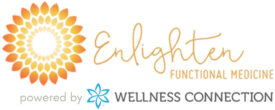Dreaming of the pitter-patter of little feet? Eliminate these unnecessary household toxic exposures to support fertility, pregnancy and overall health.
1. Clean out your kitchen cabinet
Toss: plastic storage containers, non-stick pans (PTFE/Teflon/PFOA-coated), plastic cooking utensils
Stock: glass storage containers, stainless steel/ceramic/cast iron cookware, silicone, wood or stainless steel cooking utensils
First, start your home detox in the kitchen. If you’ve already changed to an anti-inflammatory eating program to switch on your health-promoting genes, it’s time to look at another food piece: storage.
Plastic storage containers, plastic water bottles and plastic baggies are staples in most kitchens. Be a plastic detective and see how many plastic items you can replace with glass, stainless steel or silicone.
Saying No to Non-Stick
Teflon is the brand name for polytetrafluoroethylene (PTFE) and while your omelet might slide right off of that non-stick skillet, the coating isn’t doing your body any favors. Research suggests that perfluorooctanoic acid (PFOA)–which is used to make PTFE–can cause hormonal imbalances, disrupting reproduction and fetal development. [efn_note] “Endocrine disrupting properties of perfluorooctanoic acid. – NCBI – NIH.” 21 Mar. 2011, https://www.ncbi.nlm.nih.gov/pubmed/21397692. Accessed 23 Jan. 2019.[/efn_note]
Cookware Alternatives
Opt for cast iron or carbon steel pans. As you use them, a natural nonstick coating should form; however, do note that these types of pans will never be as non-stick as the toxic Teflon variety. Instead of throwing up your hands in cooking disappear, learn to master these tips:
Tips for Cooking in Stainless Steel Pans
- Lower Temps: Keep your temperatures on the lower side, opting for medium to medium-high cooking in most instances
- Embrace Fat: Without it or a liquid, like broth, everything sticks
- Be Patient: Allow the pan to preheat for 2-3 min. before adding any content
- Soak It: Stuck food? Put an equal ratio of soap water and apple cider vinegar in the pan and reheat it on the oven until food is easily removed.
2. Clean out your vitamin cabinet
Toss: folic acid-containing prenatals
Stock: folate-containing prenatals
The second stop on your home detox is your vitamin stash. You’re probably prepared to take a prenatal as soon as you know baby is on the way, but if you’re thinking of conceiving in the next 6-12 months, why not go ahead and ensure you have sufficient nutrient stores for that soon-to-be-growing lil’ nugget?
Most prenatals you can pick up in the grocery or drug store aisle contain folic acid, the synthetic form of folate. This can potentially be a problem for those who cannot properly convert folic acid.
Can I get all my nutrients from food?
While, ideally, all the needed vitamins and minerals could be supplied from the earth and the food we eat, sadly, the current condition of our soils with our modern environment and agricultural practices has resulted in diminishing stores. Your food is only as good as the soil it grows in.
You are what you absorb
Also, consider the fact that even if you’re consuming loads of high quality, micronutrient-packed fare, you’re only getting the benefit from what it is you’re actually absorbing. Low stomach acid and other digestive issues can keep your body from actually utilizing the nutrients you throw its way.
In preparation for conception, you may want to work with your practitioner to see if some nutrients need to be supplemented therapeutically.
However, taking supplements are never a get-out-of-eating-real-foods pass. Nope. Just think of it as a bit of extra insurance during this crucial time.
3. Clean out your bathroom cabinet
Toss: air fresheners, toxic bathroom cleaners, shampoos, conditioners, body wash, lotions and perfumes containing phtalates
Stock: non-toxic cleaners and personal care products like lotions, deodorants, shampoo and conditioners
Third on the household detox list is the bathroom cabinet. Phthalates are a group of chemicals that can adversely affect hormones and reproduction. They are often found in many personal care products and items with fragrances.
Mothers with higher levels of exposure to phthalates had baby boys with alterations in anatomy suggestive of fertility issues later in life, according to a 2015 article in Oxford Journal Human Reproduction.[efn_note] “First trimester phthalate exposure and anogenital … – NCBI – NIH.” 18 Feb. 2015, https://www.ncbi.nlm.nih.gov/pmc/articles/PMC4359397/. Accessed 23 Jan. 2019.[/efn_note]
4. Clean out your makeup bag
Toss: phthalates-containing cosmetics
Stock: cosmetics without fragrances, artificial colors and phtalates
Next, let’s look at the toxins in your makeup. Use sources like the Environmental Working Group’s website which rates cosmetics for effects on health. Enter in the name of your favorite brands and see how they score. Check health food stores or companies like Bare Minerals and W3ll People for options better than their mainstream counterparts.
5. Clean out your fridge
Toss: Caffeinated beverages, sugary soda, alcohol, plastic water bottles
Stock: Decaf coffee, herbal tea, sparkling water, stainless steel/glass water bottles
Finally, it’s time to look at the fridge.
Drink water. Hydration directly affects the ability of sperm to travel on its merry way.[efn_note] “Effects of chelating agents on the rheological property of … – NCBI – NIH.” https://www.ncbi.nlm.nih.gov/pubmed/12127644. Accessed 8 Dec. 2018.[/efn_note]
However in order to reduce toxic exposures, replace plastic water bottles with stainless steel or glass since most plastics can be an endocrine disruptor. They release chemicals that act like hormones in the body. [efn_note] “Most Plastic Products Release Estrogenic Chemicals: A … – NCBI – NIH.” https://www.ncbi.nlm.nih.gov/pmc/articles/PMC3222987/. Accessed 4 Feb. 2019.[/efn_note]
You’re probably ready to part with cocktail hour, but what about that 3:00 p.m. soda or morning cups of joe? (gulp) Lack of adequate hydration affects gene expression in the brain.[efn_note] “Hydration-sensitive gene expression in brain. – NCBI.” 17 Jun. 2011, https://www.ncbi.nlm.nih.gov/pubmed/21691093. Accessed 8 Dec. 2018.[/efn_note] So trading your latte for a lot more water might be a good idea.
Also, intake of sugary sodas and energy drinks detrimentally affect fertility in both men in women.[efn_note] “Intake of Sugar-sweetened Beverages and … – LWW Journals.” https://journals.lww.com/epidem/Fulltext/2018/05000/Intake_of_Sugar_sweetened_Beverages_and.8.aspx. Accessed 8 Dec. 2018.[/efn_note] Caffeine can decrease fallopian tube activity and thus affects fertility.
A 2017 meta-analysis of all the research on caffeine and pregnancy concluded that drinking more than 300 mg of caffeine a day increased the risk of pregnancy loss and drinking twice that much or more than doubled the risk of loss.[efn_note] “Association between coffee or caffeine consumption and … – NCBI.” https://www.ncbi.nlm.nih.gov/pubmed/29276412. Accessed 23 Jan. 2019.[/efn_note]
Upgrade your water
Add Fruit
Think water and herbal tea is ho-hum? Try adding frozen berries, freshly sliced cucumbers or fresh herbs like mint and rosemary. Use fancy glass water pitcher or water bottle and fill it up each morning, toss in your favorite add-in’s and sip throughout the day.
Invest in a Filter
Purchasing a water filter can decrease exposure to additional toxins sometimes found in tap water such as pesticides and other chemicals.
Become a Detox and Fertility Master
Overwhelmed with making your pre-baby, fertility-optimization plan? Learn more at the Functional Fertility Intensive online workshop.
You can glean wisdom from three experienced functional medicine practitioners focused on women’s health and fertility. Get valuable, actionable items and gain priceless insight for both you and your partner.
Three functional medicine professionals, one setting, one-fraction of the price for a one-on-one consult is available to you now for only $35. Learn more.
Want one-on-one support?
Setup a consult with Dr. Emily where you can take a deep-dive into your health history and make a plan on how to best support your body and your unique needs.
Action Steps:
1. Choose one room of the house to evaluate this week.
Take inventory of the products there that might need to be tossed. Investigate a nontoxic replacement for at least one item.
2. Visit the Environmental Working Group’s website.
Discover how your personal care items measure up to nontoxic standards. Prioritize which items to replace first.
3. Buy a spray bottle to make your own cleaner for everyday use.
Mix 2 tsp borax, 4 tbsp vinegar and 3 c hot water. Consider adding ¼ tsp liquid castile soap for a stronger cleaning solution.
4. Investigate what natural cleaning products are available where you usually shop.
Saint Louis-based company Better Life has a variety of cleaners available at local grocery stores.
Non-toxic multi-purpose cleaner such as Bon Amni may be more widely available and can be used for sticky messes on stainless steel pans, stubborn grease on the stovetop or rings around the bath tub.
Sources:
- “Endocrine disrupting properties of perfluorooctanoic acid. – NCBI – NIH.” 21 Mar. 2011, https://www.ncbi.nlm.nih.gov/pubmed/21397692. Accessed 23 Jan. 2019.
- “First trimester phthalate exposure and anogenital … – NCBI – NIH.” 18 Feb. 2015, https://www.ncbi.nlm.nih.gov/pmc/articles/PMC4359397/. Accessed 23 Jan. 2019.
- “Effects of chelating agents on the rheological property of … – NCBI – NIH.” https://www.ncbi.nlm.nih.gov/pubmed/12127644. Accessed 8 Dec. 2018.
- “Most Plastic Products Release Estrogenic Chemicals: A … – NCBI – NIH.” https://www.ncbi.nlm.nih.gov/pmc/articles/PMC3222987/. Accessed 4 Feb. 2019.
- “Hydration-sensitive gene expression in brain. – NCBI.” 17 Jun. 2011, https://www.ncbi.nlm.nih.gov/pubmed/21691093. Accessed 8 Dec. 2018.
- “Intake of Sugar-sweetened Beverages and … – LWW Journals.” https://journals.lww.com/epidem/Fulltext/2018/05000/Intake_of_Sugar_sweetened_Beverages_and.8.aspx. Accessed 8 Dec. 2018.
- “Association between coffee or caffeine consumption and … – NCBI.” https://www.ncbi.nlm.nih.gov/pubmed/29276412. Accessed 23 Jan. 2019.






